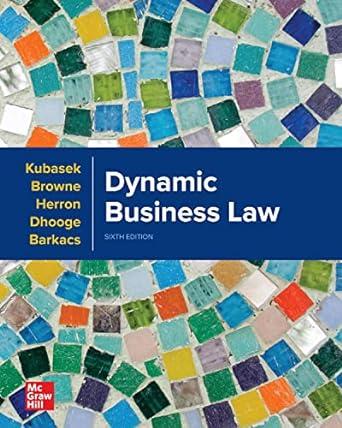Question
CIRAC evaluation of The Case of Kansas v. Hendricks, 521 U.S. 346 (1997) here. https://www.leagle.com/decision/1997867521us3461859 Example of CIRAC Conclusion -give me the answer to the
CIRAC evaluation of The Case of Kansas v. Hendricks, 521 U.S. 346 (1997) here. https://www.leagle.com/decision/1997867521us3461859
Example of CIRAC
Conclusion-give me the answer to the question-Ex: Yes, the person violated the law because under the Vehicle and Traffic Law one cannot drink and drive. Issue-what is the issue in the case? Ex:Can an individual drink alcohol and then operate a vehicle? Rule-The law that applies to the facts at hand-Ex: Under Vehicle and Traffic Law section 23.22 it states an individual cannot drink and drive. Analysis-The reasoning the court used to make its decision-Ex: John had drank six beers and then got behind the wheel, under the Vehicle and Traffic Law he violated the law and is subject to his license being revoked. Conclusion-bottom line again-same as your first sentence above-- *Basically, get right into the issue and rule etc. and then go back and put your conclusion at the beginning at then end. This method helps you to logically approach and analyze a legal question.
Here is an example of a CIRAC submission:
Conclusion- The physician and hospital administrator should have communicated about this patient's living will in order to best plan for the patient's end of life wishes.
Issue- Can the patient be taken off of life support within the terms of that patient's living will, even if that goes against the hospital's policy?
Rule- David's living will gave him the legal right to be taken off of life support and be ordered a DNR because of his wish not to be kept alive under extraordinary means. The hospital does not allow a patient to be removed from a respirator without a court order, or with any hospital staff present for the discontinuation.
Analysis- The physician and David had a common understanding of David's living will that stated David did not want to be kept alive through extraordinary means. When David was ready to go there became a miscommunication between the physician and hospital administrator on the policy in place for meeting David's wishes. A court order to take David off of the respirator should have been known and clearly stated by the physician to David and his family. In order to meet David's wishes without an extended amount of suffering, the physician removes David from the hospital for his respirator to be removed at home. The physician and family must have agreed that this is the best option for David to get what he wanted from hiss living will.
Conclusion- The physician and hospital administrator should have communicated about this patient's living will in order to best plan for the patient's end of life wishes.
Step by Step Solution
There are 3 Steps involved in it
Step: 1

Get Instant Access to Expert-Tailored Solutions
See step-by-step solutions with expert insights and AI powered tools for academic success
Step: 2

Step: 3

Ace Your Homework with AI
Get the answers you need in no time with our AI-driven, step-by-step assistance
Get Started


